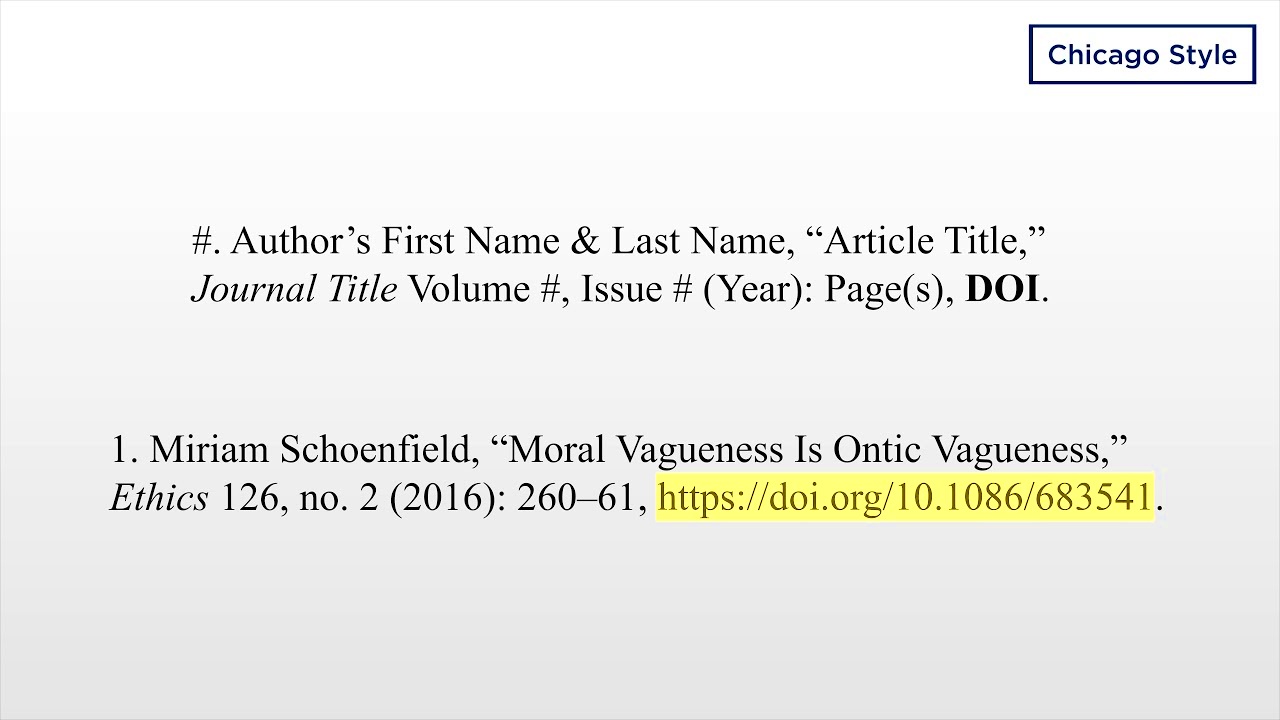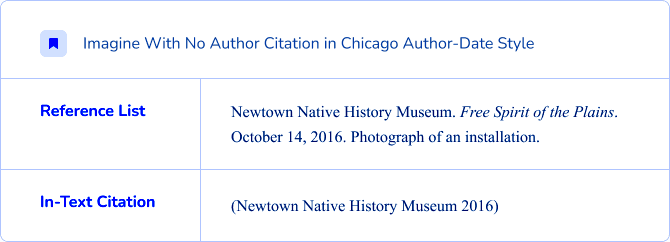Citing images correctly is essential when creating academic or professional work. Whether you're using images from a museum, online gallery, or personal collection, giving proper credit is a key aspect of academic integrity. The Chicago Manual of Style offers a clear and structured way to cite visual materials, helping you avoid plagiarism and recognize the work of creators. In this section, we’ll introduce you to the basics of citing images in Chicago Style, making the process simple and easy to follow.
Understanding Chicago Style Citation for Images

Chicago Style is one of the most commonly used citation styles in academic writing. It provides detailed rules on how to cite various types of sources, including images. There are two primary systems within Chicago Style: the Notes and Bibliography system and the Author-Date system. When citing images, the format you choose depends on your overall citation style.
In both systems, images should be cited properly to give credit to the creators and help readers locate the source of the image. Below is a brief breakdown of the two systems:
- Notes and Bibliography: This system is often used in the humanities and focuses on footnotes or endnotes to reference sources. It’s ideal for citing a wide range of materials, including books, articles, and images.
- Author-Date: This system is used primarily in the sciences and social sciences. Citations are placed in parentheses within the text and include the author's name and publication year.
Regardless of the system you use, Chicago Style ensures that all necessary details are included so readers can find the image you referenced. The citation should be clear, concise, and consistent.
Elements Required for Proper Image Citation
When citing an image in Chicago Style, there are several key elements you need to include in your citation. Each of these elements helps identify the image and its source. Here's a list of the most common components:
- Creator/Artist's Name: Include the full name of the person or group responsible for creating the image. If the artist is unknown, use "Unknown" or "Anonymous" in place of a name.
- Title of the Image: The title should be in italics or quotation marks, depending on the format. Include any additional details, such as medium or dimensions if available.
- Date of Creation: If the exact date is unknown, try to find the year or approximate time period the image was created.
- Source or Location: Include where the image is stored, whether it's a physical location like a museum or gallery, or an online source such as a website or database.
- URL or DOI (if online): If the image is found online, be sure to provide the URL or DOI (Digital Object Identifier), so others can easily access it.
Here’s an example format for citing an image in Chicago Style:
| Creator: | John Doe |
| Title: | The Sunset |
| Year: | 1995 |
| Source: | Art Museum, Chicago |
| URL: | https://www.example.com |
By including all the necessary elements, you can ensure that your image citation is both complete and accurate.
Steps to Cite an Image in Chicago Style
Citing an image in Chicago Style may seem complex at first, but breaking it down into clear steps can make the process much easier. By following the standard citation format, you'll ensure that the creator of the image gets proper credit and that your work maintains academic integrity. Here's a step-by-step guide to help you cite an image correctly in Chicago Style:
- Identify the Image Source: Determine whether the image comes from a physical location (like a museum) or an online source. This will affect how you format the citation.
- Gather the Required Information: Collect the following details about the image:
- Creator/artist’s full name
- Title of the image
- Date of creation or publication
- Source or location (museum, gallery, website, etc.)
- For online images, include the URL or DOI
- Choose the Citation System: Decide whether you will use the Notes and Bibliography system or the Author-Date system, based on your assignment or style guide instructions.
- Format the Citation: Use the proper format for the chosen system, ensuring that all necessary elements are included. Double-check punctuation, italics, and spacing.
- Review Your Citation: Make sure the citation is complete and accurate. Check that all elements are in the correct order and that no information is missing.
By following these simple steps, you can easily cite any image in Chicago Style and avoid errors that might affect the credibility of your work.
Examples of Image Citations in Chicago Style
Understanding how to structure your citation is crucial for proper attribution. Below are examples of how to cite various types of images using Chicago Style, depending on whether you’re using the Notes and Bibliography or Author-Date system.
1. Example for Notes and Bibliography System:
Footnote:
John Doe, The Sunset (Chicago: Art Museum, 1995), 45.
Bibliography:
Doe, John. The Sunset. Chicago: Art Museum, 1995.
2. Example for Author-Date System:
In-Text Citation:
(Doe 1995)
Reference List:
Doe, John. 1995. The Sunset. Chicago: Art Museum.
3. Example for an Online Image (Notes and Bibliography):
Footnote:
John Doe, The Sunset, 1995, Art Museum, accessed November 23, 2024, https://www.example.com.
Bibliography:
Doe, John. The Sunset. 1995. Art Museum. Accessed November 23, 2024. https://www.example.com.
By adapting these formats to fit your specific needs, you can accurately cite a wide range of images in Chicago Style.
Common Mistakes to Avoid in Image Citations
When citing images, it’s easy to make mistakes that can affect the clarity and accuracy of your references. Here are some common errors to watch out for when citing images in Chicago Style:
- Missing Information: Ensure that all necessary details are included, such as the creator's name, image title, source, and date. Missing information can make it difficult for readers to find the image.
- Incorrect Formatting: Chicago Style has specific rules for punctuation, italics, and capitalization. Pay close attention to these details to avoid formatting mistakes that can make your citation look unprofessional.
- Incorrect Citation System: Make sure you are using the correct system (Notes and Bibliography vs. Author-Date). Mixing the two can lead to confusion and inconsistency in your work.
- Not Including a URL for Online Sources: If you are citing an online image, always include the full URL or DOI. Without this, your citation may be incomplete and readers won’t be able to access the source.
- Not Updating for Changes: If the image you are citing has updated information, such as a new publisher or a different location, make sure your citation reflects those changes. Always check your sources for accuracy before citing.
By avoiding these common mistakes, you can ensure that your image citations are accurate, complete, and in line with Chicago Style guidelines.
Tools to Help You Cite Images in Chicago Style
Citing images in Chicago Style can feel like a daunting task, but there are several helpful tools available to make the process faster and more accurate. These tools can assist you in formatting citations properly, ensuring that you don't miss any important details. Here’s a look at some popular tools you can use:
- Citation Generators: Websites like Citation Machine and BibMe provide easy-to-use citation templates. Simply input your image details, and the generator will create a citation in Chicago Style.
- Reference Management Software: Tools such as Zotero and Mendeley allow you to organize your references and easily generate citations in Chicago Style for all kinds of sources, including images.
- Online Style Guides: The official Chicago Manual of Style website (chicagomanualofstyle.org) offers detailed guidelines and examples for citing images and other sources. It’s a great place to verify your citations and ensure you’re following the right format.
- Word Processing Tools: Microsoft Word and Google Docs both have built-in citation tools that can generate Chicago Style citations. These are convenient for quick references and in-text citations.
By using these tools, you can save time and avoid the frustration of manually formatting each image citation. They help streamline the citation process, allowing you to focus more on your work rather than on formatting issues.
Why Proper Image Citation Matters
Proper image citation is not just about following academic rules – it’s about respecting the work of creators and ensuring the integrity of your own work. Here are several reasons why citing images correctly matters:
- Avoiding Plagiarism: Citing an image properly gives credit to the original creator, ensuring you’re not unintentionally presenting their work as your own.
- Supporting Your Arguments: Images can strengthen your arguments and add visual context to your writing. Properly citing images helps readers trace their origin, providing legitimacy to your work.
- Respecting Copyright Laws: Images are copyrighted materials, and using them without proper citation could result in legal issues. Citation protects both you and the original creator from potential copyright infringement.
- Enhancing Reader Experience: Proper citation allows your audience to find the original sources, enabling them to explore images and gain a deeper understanding of the topic.
- Building Credibility: Correctly citing images adds to the overall professionalism and credibility of your work. It shows attention to detail and respect for source material.
By following Chicago Style citation guidelines for images, you demonstrate both academic integrity and respect for intellectual property, which are key to creating trustworthy and well-researched content.
FAQ
Here are some frequently asked questions about citing images in Chicago Style, with answers to help clear up any confusion:
- Q: Can I cite an image from a book?
- Q: What if the creator of the image is unknown?
- Q: How do I cite an image from a website?
- Q: Do I need to include the URL for images in physical locations?
- Q: Can I skip the date of creation?
A: Yes! If you're citing an image from a book, treat the book as the source. Include the author's name, the book title, the publisher, and page number where the image appears.
A: If the image creator is unknown, you can start the citation with the title of the image, followed by the source or location. For example: The Sunset (Art Museum, 1995).
A: For an image found online, make sure to include the image title, creator (if available), the website name, the publication date (if available), and the full URL where the image can be accessed.
A: No, if the image is housed in a physical location (like a museum or gallery), you don’t need to include a URL. However, you must provide the location details such as the museum's name and city.
A: If the creation date is not available, you can use "n.d." (no date) in place of the date. However, you should always try to find the creation year if possible.
If you still have questions or need more specific examples, refer to the official Chicago Manual of Style or consult a citation tool to ensure accuracy in your citations.
Conclusion
In conclusion, citing images in Chicago Style is an essential practice for maintaining academic integrity, giving proper credit to creators, and ensuring the credibility of your work. By following the step-by-step guidelines, using helpful tools, and avoiding common mistakes, you can easily incorporate images into your writing while adhering to proper citation standards. Whether you're working on a research paper, blog, or any other project, correctly citing images will not only protect you from plagiarism but also enhance the professionalism of your work. Remember, a well-cited image is an essential part of a well-researched piece, and it shows respect for the intellectual property of others.











